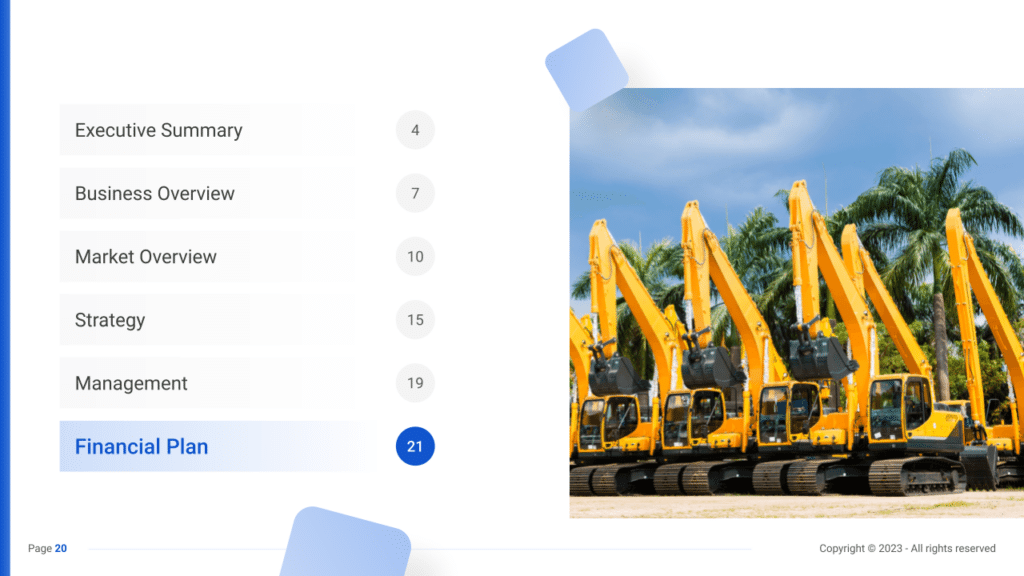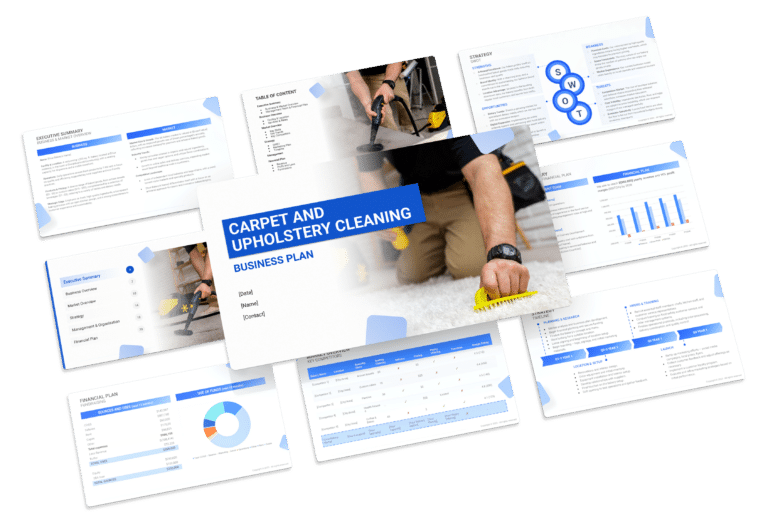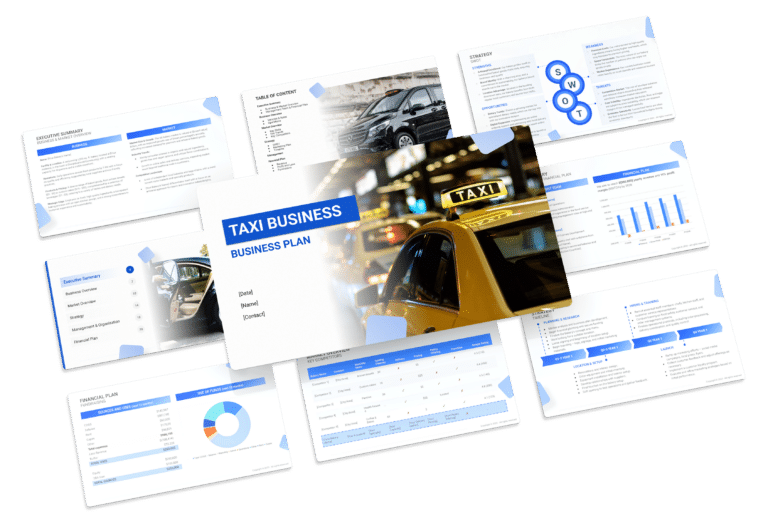Equipment Rental Business Plan Template & PDF Example
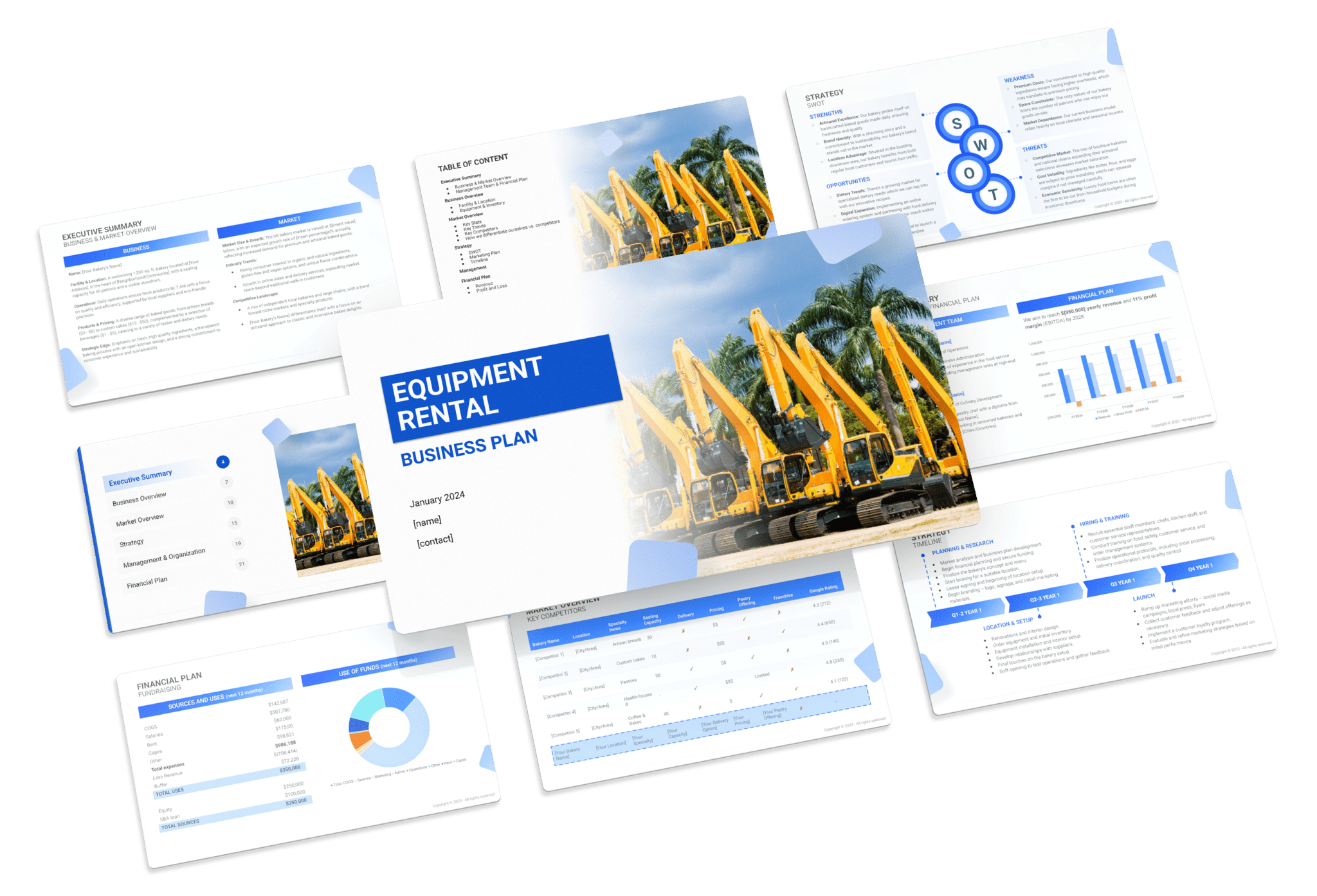
Creating a comprehensive business plan is crucial for launching and running a successful equipment rental business. This plan serves as your roadmap, detailing your vision, operational strategies, and financial plan. It helps establish your equipment rental business’s identity, navigate the competitive market, and secure funding for growth.
This article not only breaks down the critical components of an equipment rental business plan, but also provides an example of a business plan to help you craft your own.
Whether you’re an experienced entrepreneur or new to the service industry, this guide, complete with a business plan example, lays the groundwork for turning your equipment rental business concept into reality. Let’s dive in!
The Plan
Our equipment rental business plan is structured to encompass all critical components necessary for a detailed strategic approach. It outlines the operations of our rental service, our marketing strategies, the market environment, competitive analysis, our management team, and financial projections.
- Executive Summary: Offers an overview of your equipment rental business’s concept, market analysis, management, and financial strategy.
- Business Overview: Provides detailed information on what your equipment rental company offers and its operational model:
- Company & Location: Describes the business’s operational setup, storage facilities, and why its location benefits the target market.
- Equipment & Pricing: Lists the types of equipment available for rent, including pricing structure and any special rental terms.
- Market Overview: Examines the equipment rental industry landscape, identifies competitors, and how your business stands out:
- Key Stats: Shares industry size, growth trends, and relevant statistics for the equipment rental market.
- Key Trends: Highlights recent trends affecting the equipment rental sector, such as technological advancements or shifts in consumer behavior.
- Key Competitors: Analyzes main competitors in your area and how your business offers a competitive edge.
- Strategy: Outlines how the Equipment Rental business intends to achieve growth and attract clients:
- SWOT: Conducts a Strengths, Weaknesses, Opportunities, and Threats analysis tailored to the equipment rental industry.
- Marketing Plan: Develops strategies for promoting your equipment rental services and building a loyal customer base.
- Timeline: Establishes key milestones and objectives from the initial setup through the first year of operation and beyond.
- Management: Information on who manages the Equipment Rental business, detailing their roles, experience, and qualifications in the industry.
- Financial Plan: Projects the business’s 5-year financial performance, including revenue from different types of equipment rentals, operational expenses, and profitability estimates.

Executive Summary
The executive summary for your equipment rental business plan provides a succinct overview of your company, detailing the types of equipment available for rent, its market positioning, and the specific needs it addresses within the industry. It should outline the variety of equipment offered, the business’s location, size, and a snapshot of daily operations.
This section will also delve into how your equipment rental business will carve out its niche in the local market, including an analysis of direct competitors in the vicinity, identifying who they are, and highlighting your business’s unique selling propositions that set it apart from these competitors.
Moreover, it’s essential to include information about the management and co-founding team, elaborating on their roles and how their expertise and experience contribute to the business’s success.
A summary of your financial projections, including expected revenue and profit margins over the next five years, should also be included to provide a comprehensive view of your business’s financial outlook.
Equipment Rental Business Plan Executive Summary Example
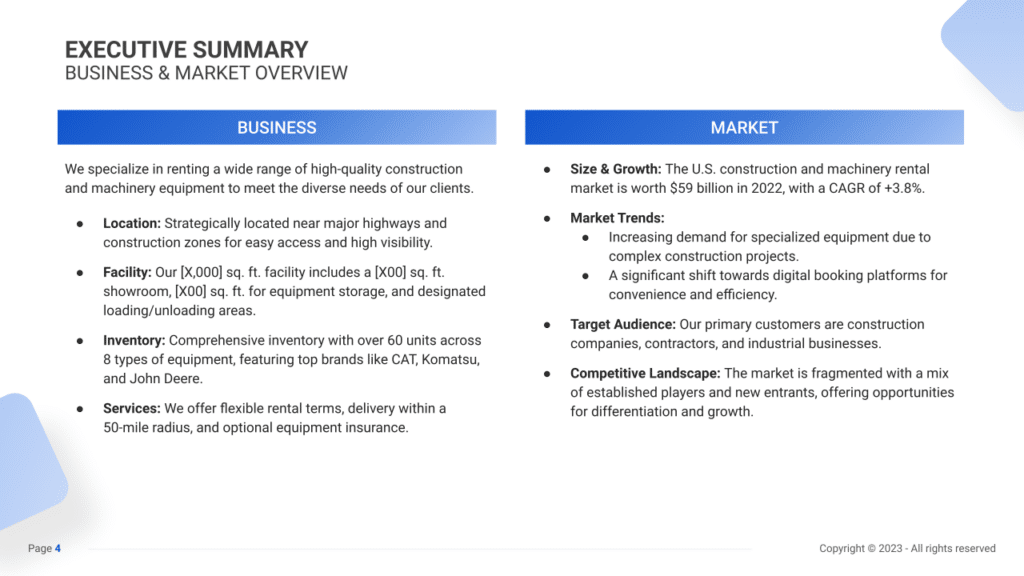
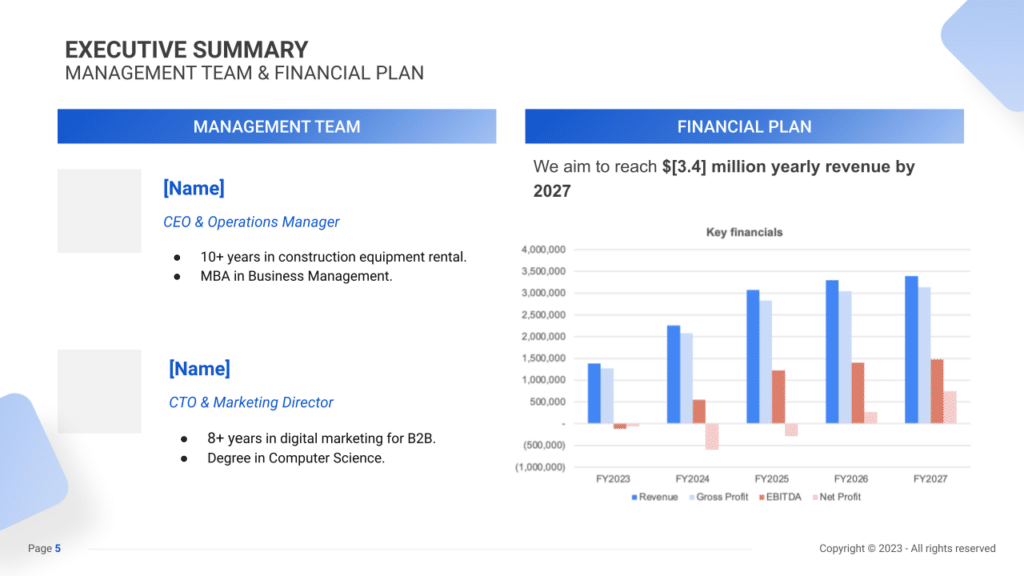
Business Overview
The business overview section of an equipment rental company’s executive summary should provide a comprehensive description of the company’s services, inventory, and operational features.
It is important to highlight the range of equipment offered, ensuring that it aligns with the needs of the target audience, which includes construction companies, contractors, and industrial businesses.
The overview should also emphasize the strategic location of the facility, its capacity, and how it facilitates efficient operations.
Additionally, detailing services like flexible rental terms, delivery options, and additional benefits like equipment insurance is important to showcase the company’s commitment to meeting client needs and providing value-added services.
Example:
The equipment rental company, located near major highways and construction zones, offers a diverse inventory of over 60 units of high-quality construction and machinery equipment. The 10,000 sq. ft. facility includes a spacious showroom and ample storage, ensuring a wide selection and availability of equipment from top brands. The company caters to its clients with flexible rental terms and convenient delivery services, enhancing customer experience and operational efficiency.
Market Overview
In the market analysis section, the focus is on the size, growth, and trends of the U.S. construction and machinery rental market.
This part of the summary provides insight into the industry’s dynamics, including the increasing demand for specialized equipment and the shift towards digital booking platforms. Understanding these trends is crucial for positioning the company in a way that aligns with market needs and opportunities.
Additionally, an analysis of the competitive landscape is important to identify potential areas for differentiation and growth strategies.
Example:
The U.S. construction and machinery rental market, valued at $59 billion, is experiencing steady growth. With a trend towards more complex construction projects and digital solutions, the company is well-positioned to meet these evolving demands. Despite a fragmented market with established players and new entrants, the company differentiates itself through its extensive inventory and digitalized customer service.
Management Team
This section outlines the backgrounds and roles of the management team, emphasizing their experience and expertise relevant to the equipment rental business.
It is important to highlight the skills and qualifications that each member brings to the table, such as experience in construction equipment rental, business management, digital marketing, and technology. The management team’s capabilities are a key factor in the company’s ability to execute its business strategy and achieve its objectives.
Example:
The CEO, with over 10 years in construction equipment rental and an MBA in Business Management, leads the company’s operations and strategic planning. The CTO, holding a degree in Computer Science and with 8 years in digital marketing for B2B, drives the company’s marketing efforts and digital platform development.
Financial Plan
The financial plan overview should present the company’s revenue and profit targets, offering a clear forecast of its financial aspirations.
This includes outlining specific financial objectives, such as reaching $3.4 million in annual revenue by 2027, and the strategies in place to achieve these goals.
This section reflects the company’s financial health and growth potential, considering factors like market expansion, inventory management, and customer acquisition strategies.
Example:
The company aims to achieve $3.4 million in yearly revenue by 2027, with a focus on expanding its client base in the construction industry and enhancing its digital presence for customer engagement. This financial goal is supported by strategic inventory management, targeted marketing campaigns, and leveraging technology to improve customer service and operational efficiency.
Business Overview
For an equipment rental business, the Business Overview section can be effectively divided into 2 main segments:
Company & Location
For example: Our equipment rental facility boasts a streamlined, customer-friendly environment, designed to make equipment selection and rental a breeze. Conveniently situated with easy access to major business districts and event locations, our site offers ample parking and is near key transport routes, making it an ideal choice for a wide range of customer needs.
Equipment & Pricing
For example: We offer an extensive array of rental equipment, from heavy-duty construction machinery to essential event gear, all maintained to the highest standards for reliability and performance. Our pricing is competitive and reflects the premium quality of our equipment and service, with flexible rental terms to suit various project timelines. Special incentives, such as loyalty discounts and tailored package deals, are available to enhance value and foster long-term customer relationships.


Market Overview
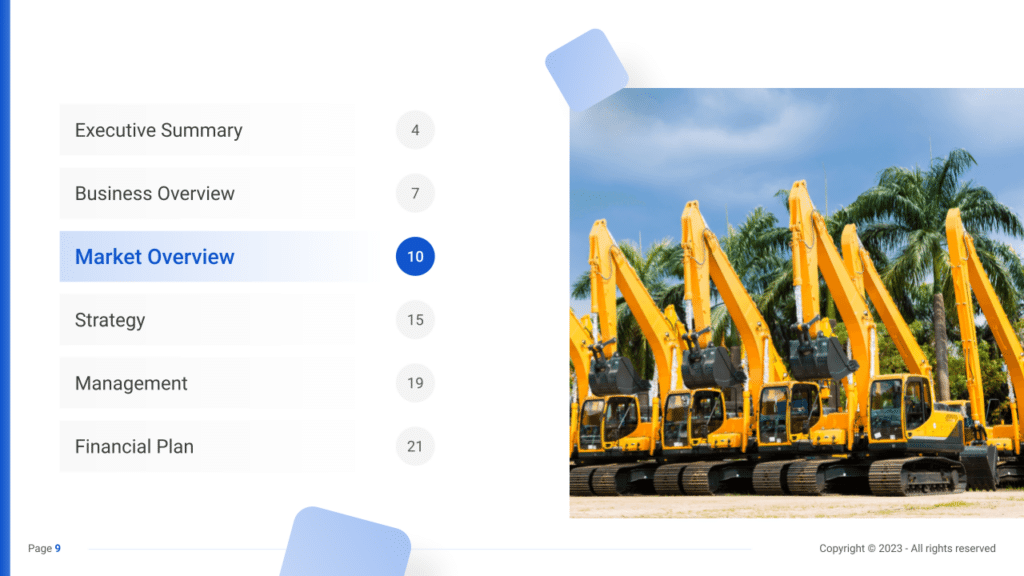
Industry Size & Growth
In the market overview for your equipment rental business plan, begin by analyzing the size of the equipment rental industry and its potential for growth. This examination is vital for grasping the market’s breadth and pinpointing avenues for expansion.
Key Market Trends
Next, delve into the prevailing market trends, such as the growing demand for specialized equipment rental in sectors like construction, events, and film production.
Highlight the shift towards flexible rental solutions that accommodate project-based needs and the increasing preference for renting over purchasing expensive equipment to reduce capital expenditure. For instance, underline the surge in demand for the latest technology and environmentally friendly equipment options.
Competitive Landscape
A competitive analysis is not just a tool for gauging the position of your equipment rental in the market and its key competitors; it’s also a fundamental component of your business plan.
This analysis helps identify your bakery’s unique selling points, essential for differentiating your business in a competitive market.
In addition, competitive analysis is integral in laying a solid foundation for your business plan. By examining various operational aspects of your competitors, you gain valuable information that ensures your business plan is robust, informed, and tailored to succeed in the current market environment.
Identifying Your Competitors in the Equipment Rental Industry
The first step towards gaining a comprehensive understanding of your business’s standing involves identifying your direct and indirect competitors in the equipment rental sector. Direct competitors might include local equipment rental firms offering a similar range of tools and machinery, while indirect competitors could encompass larger retailers that also provide equipment rental services as part of their offerings.
Utilize various resources to pinpoint competitors, such as industry directories, online listings, and professional networks. Websites like Yellow Pages or industry-specific databases can help identify regional and national players. Additionally, customer reviews and feedback on platforms like Trustpilot or specialized equipment forums can offer valuable insights into competitor strengths and weaknesses.
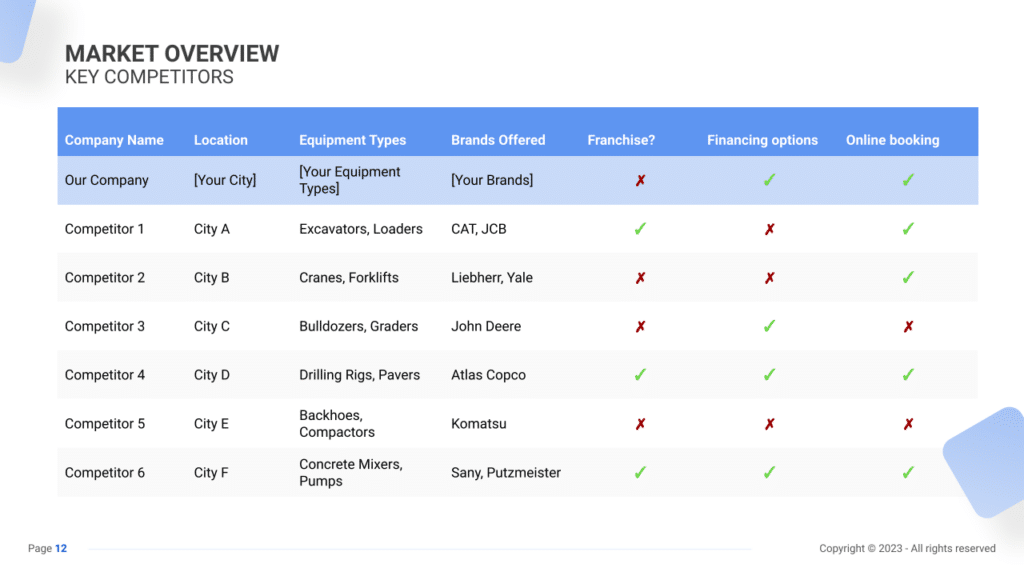
Equipment Rental Competitors’ Strategies in the Market
Examining competitors’ strategies involves dissecting several facets of their business operations:
Inventory Offerings: Assess the types of equipment and machinery your competitors provide for rental. Are they focusing on a specific niche, such as construction, home improvement, or specialized tools?
- Service Quality: Evaluate the quality of service offered by competitors. Do they emphasize swift delivery, well-maintained equipment, or exceptional customer support?
- Pricing Structures: Compare the pricing models of competitors. Are they positioning themselves as budget-friendly options like “Economical Rentals” or premium services like “Professional Tools Co.”?
- Marketing and Outreach: Scrutinize competitors’ marketing tactics. Are they leveraging digital marketing, partnerships with construction companies, or targeted advertising in trade publications?
- Customer Experience: Analyze the overall customer experience provided by competitors. Do they offer user-friendly online platforms for bookings or provide personalized consultations?
- Technological Advancements: Investigate if competitors are adopting innovative technologies, such as IoT-enabled equipment or online portals for equipment monitoring and maintenance.
What’s Your Equipment Rental Business’s Value Proposition?
Your equipment rental business must establish a unique value proposition to stand out in a crowded market. Consider what sets your business apart:
- Specialized Equipment: Highlight any unique or specialized equipment that’s exclusive to your rental inventory, offering customers access to machinery not readily available elsewhere.
- Exceptional Service: Emphasize exceptional customer service, whether it’s through round-the-clock support, maintenance guarantees, or flexible rental terms tailored to various customer needs.
- Targeted Market Segments: Identify niche markets that might be underserved by competitors. For instance, cater to specific industries like agriculture, healthcare, or event management with specialized equipment packages.
- Geographical Focus: Leverage your location to cater to specific regional needs. For instance, if you are situated in a suburban area with numerous construction projects, tailor your inventory to meet those demands.
Strategy
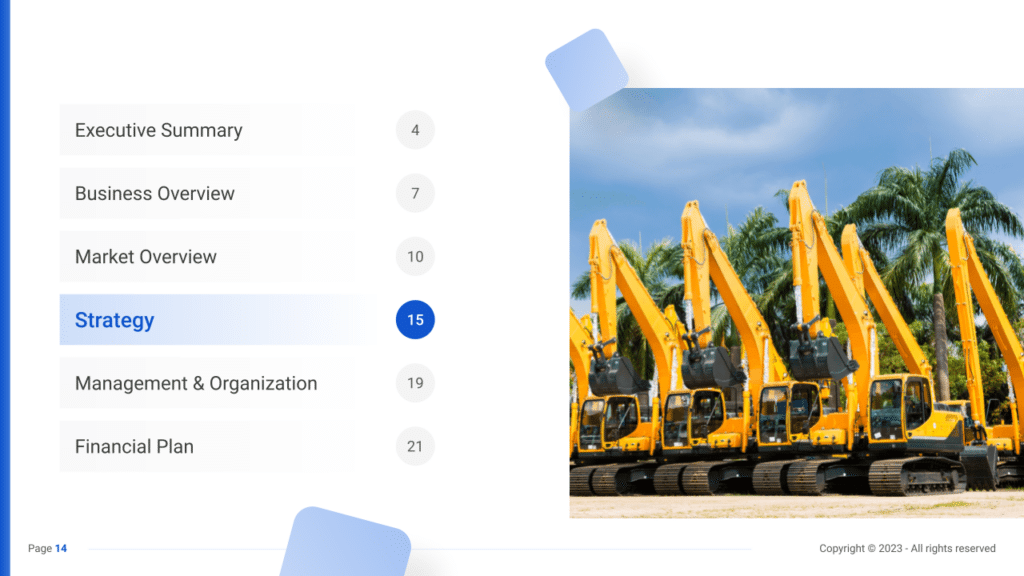
SWOT
First, perform a SWOT analysis for the equipment rental business, emphasizing Strengths (such as a comprehensive inventory and superior customer service), Weaknesses (like significant upfront investment and market competition), Opportunities (for instance, the increasing preference for renting over buying equipment), and Threats (such as economic shifts that could reduce demand for rental services).

Marketing Plan
Next, devise a marketing plan that delineates strategies to attract and retain customers through targeted advertising, competitive pricing, an engaging online presence, and active participation in industry-related events.
Marketing Channels
Marketing channels serve as avenues through which your rental business communicates with potential and existing customers. These channels are vital for enhancing brand visibility, engaging clients, and driving inquiries and bookings.
Digital Marketing
- Website and SEO: Further optimize your website by creating informative blog posts or video tutorials related to equipment usage, safety measures, or DIY project guides. Enhance user experience by implementing chat support or a comprehensive FAQ section addressing common queries. Leverage local SEO strategies to ensure higher visibility when potential customers search for rental services in your area.
- Social Media: Diversify your social media content by showcasing customer testimonials, behind-the-scenes glimpses of equipment maintenance, or success stories from clients who used your tools for their projects. Utilize platforms like TikTok for engaging short videos highlighting equipment usage tips or innovative solutions.
- Email Marketing: Segment your email list based on customer preferences or rental history to deliver tailored content. Send regular newsletters featuring seasonal promotions, maintenance tips, or exclusive discounts for specific customer segments. Encourage subscribers to engage by seeking their feedback or sharing user-generated content.
Local Advertising
- Local Directories: List your business in local directories and online platforms like Google My Business to enhance visibility.
- Community Engagement: Sponsor local events, workshops, or trade shows related to construction, home improvement, or industry-specific gatherings.
Partnerships and Networking
- Collaboration with Contractors: Forge partnerships with construction companies, event planners, or DIY enthusiasts, offering bulk rental discounts or referral programs.
- Industry Networking: Engage in industry-specific networking events, conferences, or workshops to establish connections and gain insights.
Promotional Activities
- Special Offers: Enhance your promotional activities by introducing limited-time offers tailored to specific seasons or events. Leverage the demand for certain tools during peak seasons, such as gardening equipment in spring or snow removal tools in winter.
- Loyalty Programs: Extend your loyalty program to include exclusive perks for top-tier customers, such as priority access to new equipment arrivals, dedicated account managers, or extended rental durations without additional fees.
- Referral Incentives: Amplify your referral program by offering enticing rewards not only to the referrer but also to the new customer. Consider offering tiered rewards, where both parties receive increasing benefits based on the number of successful referrals.

Sales Channels
Sales channels are the conduits through which you facilitate equipment rentals to customers. These channels are pivotal for revenue generation and ensuring customer satisfaction.
Online Booking and Reservations
- User-Friendly Platforms: Implement an intuitive online booking system for hassle-free reservations. Offer online-exclusive discounts or incentives to encourage digital bookings.
- Virtual Demonstrations: Provide virtual tours or live demonstrations of equipment operation for remote clients seeking rentals.
In-Person Sales and Services
- Customer Assistance: Train staff to provide knowledgeable assistance both in-store and via phone or email for customers seeking guidance on suitable equipment.
- Upselling Opportunities: Suggest complementary tools or accessories during customer interactions to enhance their rental experience.
Membership and Rental Programs
- Rental Memberships: Further enrich your membership plans by offering exclusive benefits such as advanced booking privileges, loyalty rewards, or access to premium tools not available to non-members.
- Rewards Program: Evolve your rewards system by introducing gamification elements like challenges or milestones that customers can achieve to unlock additional benefits. Encourage participation and engagement with your brand through these programs.
Strategy Timeline
Finally, draft a detailed timeline that specifies key milestones for the equipment rental business’s launch, marketing initiatives, customer base expansion, and goals for scaling up, ensuring a strategic approach to growth and development.

Management
The Management section focuses on the equipment rental business’s management and their direct roles in daily operations and strategic direction. This part is crucial for understanding who is responsible for making key decisions and driving the equipment rental toward its financial and operational goals.
For your equipment rental business plan, list the core team members, their specific responsibilities, and how their expertise supports the business.


Financial Plan
The Financial Plan section is a comprehensive analysis of your financial projections for revenue, expenses, and profitability. It lays out your equipment rental’s approach to securing funding, managing cash flow, and achieving breakeven.
This section typically includes detailed forecasts for the first 5 years of operation, highlighting expected revenue, operating costs, and capital expenditures.
For your equipment rental business plan, provide a snapshot of your financial statement (profit and loss, balance sheet, cash flow statement), as well as your key assumptions (e.g. number of customers and prices, expenses, etc.).
Make sure to cover here
_ Profit and Loss
_ Cash Flow Statement
_ Balance Sheet
_ Use of Funds
